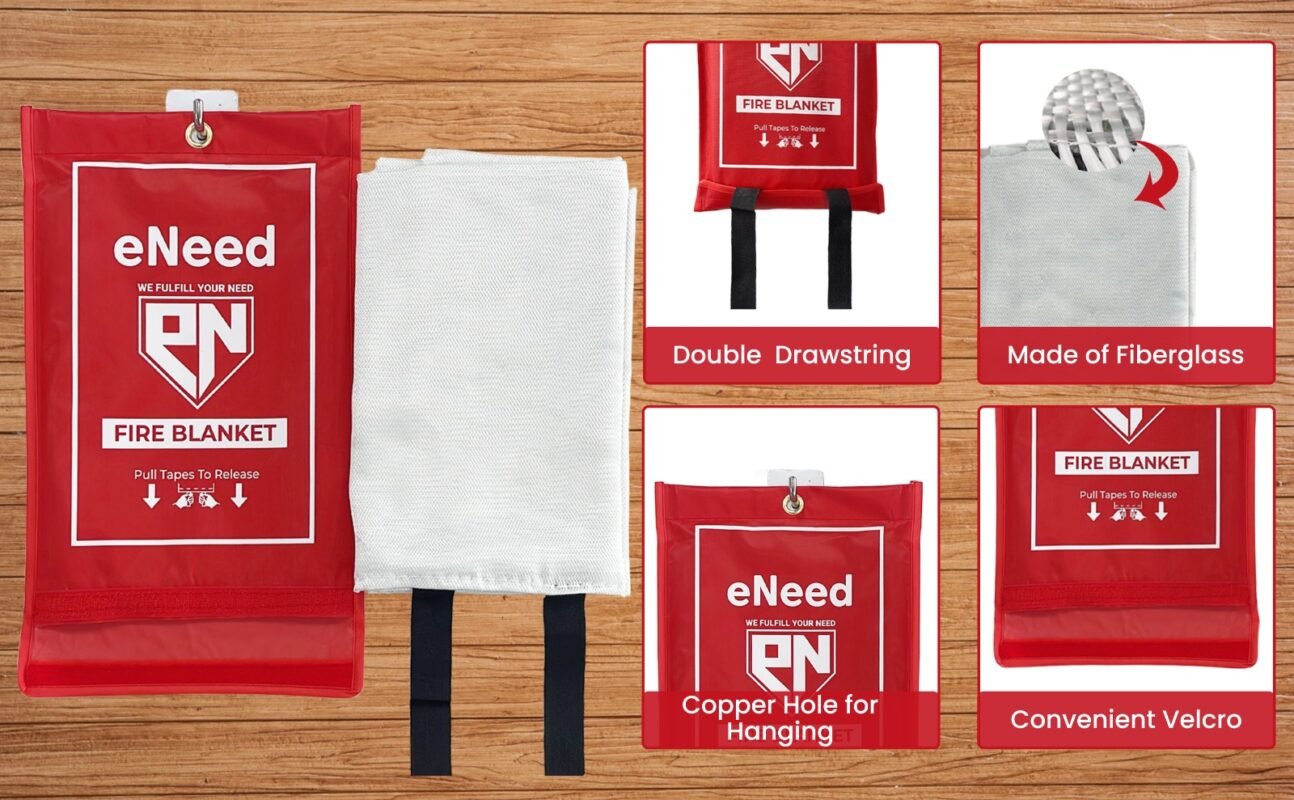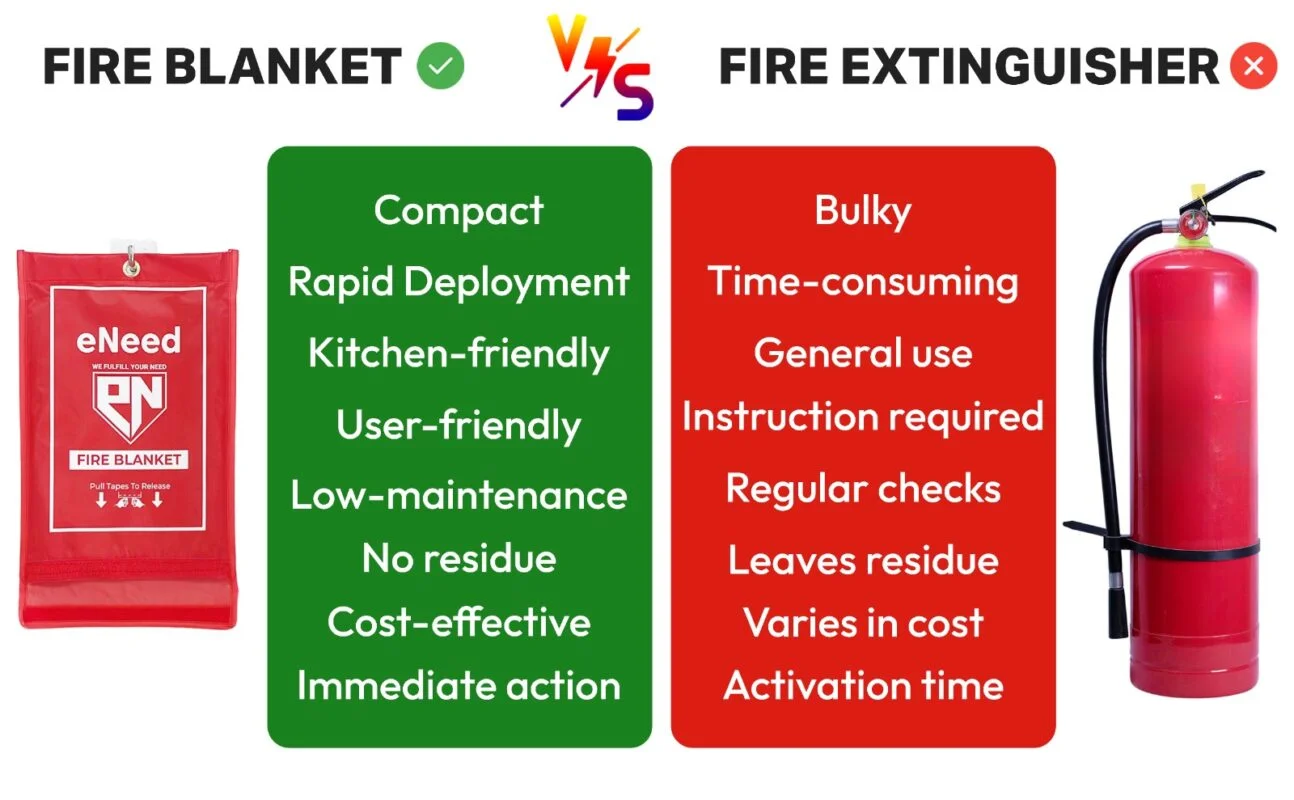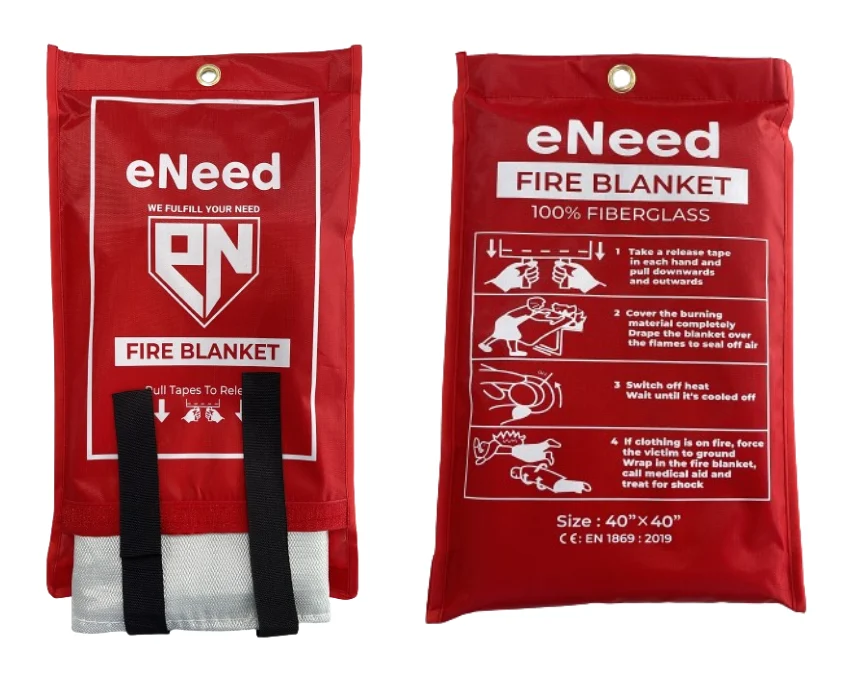Fire safety is a critical aspect of ensuring the well-being of individuals and the protection of property. In the event of a fire, having the right equipment can make all the difference. Among the essential tools in fire prevention and control, fire blanket stand out as versatile and effective. In this comprehensive guide, we explore the importance of fire safety equipment. And introduce fire blankets as indispensable assets in safeguarding residential and commercial spaces. Whether you’re a homeowner, a business owner, or a safety-conscious individual, understanding the significance of fire blankets.
eNeed fire blanket: Ensure your safety today with our high-quality fire blankets.

1. What is a Fire Blanket?
Fire blankets are a fundamental component of fire safety equipment, providing a reliable. Along With efficient method for extinguishing small fires before they escalate into more significant emergencies. Understanding the purpose, functionality, and construction of these essential tools is crucial for ensuring their effective use in safeguarding lives and property.
The primary purpose of a fire blanket is to smother flames by cutting off the fire’s oxygen supply, thereby depriving it of the fuel it needs to continue burning. This quick and efficient method of extinguishment can help prevent fires from spreading and causing further damage, making fire blankets particularly useful for tackling small fires in their early stages.
Fire blankets are typically made from fire-resistant materials such as fiberglass or wool, chosen for their ability to withstand high temperatures and resist burning. These materials are woven together to create multiple layers of fabric, forming a durable and heat-resistant barrier that can effectively smother flames. Additionally, fire blankets are often treated with fire-retardant chemicals to further enhance their fire-resistant properties and prevent ignition.
The construction of a fire blanket plays a crucial role in its functionality and effectiveness. The multiple layers of fire-resistant fabric not only help to smother flames but also provide thermal insulation to protect the user from heat and burns. This insulation is particularly important when using the blanket to extinguish fires involving flammable liquids or electrical equipment, where the risk of burns is heightened.
In addition to their use in extinguishing fires, fire blankets can also be used as protective barriers, shielding individuals from heat and flames during evacuations or rescue operations. Their versatility and effectiveness make fire blankets indispensable tools in a wide range of fire safety scenarios, from residential kitchens to industrial settings.
2. How Does a Fire Blanket Work in Action?
2.1 The Mechanics Behind Safe Fire Suppression
Understanding how a fire blanket works in action is crucial for effectively utilizing this essential safety tool. When confronted with a small fire, whether in a residential kitchen or a workplace setting, knowing how to deploy a fire blanket can make all the difference in swiftly and safely extinguishing the flames.
Fire blankets operate on a simple yet effective principle: smothering the fire by cutting off its oxygen supply. The mechanics behind this process are straightforward: when the fire blanket is placed over the flames, it creates a barrier between the fire and the surrounding air, preventing the flames from accessing the oxygen they need to sustain combustion.
As the fire blanket covers the burning material, it begins to absorb heat and gases emitted by the fire. Simultaneously, the dense fabric of the blanket blocks oxygen from reaching the flames, depriving them of the fuel they require to continue burning. This dual action effectively suppresses the fire, causing it to extinguish within moments.
2.2 Identifying Fire Types Suited for Fire Blankets’ Intervention
While fire blankets are highly effective for extinguishing certain types of fires, it’s essential to recognize the types of fires best suited for their intervention. Fire blankets are particularly well-suited for Class A fires, which involve common combustible materials such as wood, paper, and fabric. When deployed promptly, fire blankets can smother these fires effectively, preventing them from spreading and causing further damage.
Additionally, fire blankets can be used to extinguish Class B fires, which involve flammable liquids such as oil, grease, or gasoline. By covering the container or surface engulfed in flames, the fire blanket can help cut off the fire’s oxygen supply and suppress the flames. However, it’s essential to exercise caution when using fire blankets for Class B fires, as the blanket may not be able to withstand the intense heat generated by burning liquids.

3. Strategic Placement of Fire Blankets
Fire blankets are invaluable safety assets, but their effectiveness relies heavily on strategic placement within homes, workplaces, and public areas. Understanding where to deploy fire blankets optimally and ensuring easy accessibility are key factors in enhancing fire safety protocols.
3.1 Optimal Locations for Deployment in Homes, Workplaces, and Public Areas
- Kitchens: The kitchen is a common area where fires may originate, often due to cooking mishaps or appliance malfunctions. Placing a fire blanket in close proximity to the stove or oven can facilitate swift response in the event of a cooking-related fire. Mounting the blanket on a wall or storing it in a designated cabinet ensures easy access without obstructing cooking activities.
- Workshops and Garages: Workshops and garages are prone to fires resulting from activities such as welding, soldering, or the use of power tools. Installing fire blankets near workstations or fire-prone equipment provides immediate access for containment of small fires. Ensure that the blankets are stored in visible locations and easily reachable in case of emergencies.
- Commercial Settings: In commercial environments such as restaurants, laboratories, or manufacturing facilities, fire blankets should be strategically placed in areas where fire risks are elevated. Identify locations where flammable materials are stored or where equipment operations pose a fire hazard. Placing fire blankets near these areas ensures prompt intervention and containment of fires.
- Public Areas: Public buildings, including schools, hospitals, and recreational facilities, should also be equipped with fire blankets in key locations. High-traffic areas such as corridors, assembly points, or communal kitchens are ideal spots for installing fire blankets. Additionally, consider placing fire blankets near potential ignition sources such as electrical panels or heating systems to mitigate fire risks effectively.
3.2 Ensuring Accessibility: Key Spots for Quick Response
- Visible and Unobstructed Locations: Fire blankets should be prominently displayed in areas where they are easily visible and accessible to occupants. Avoid storing blankets behind closed doors or in areas prone to clutter, as this may impede quick retrieval during emergencies.
- Near Fire Exits: Positioning fire blankets near fire exits or evacuation routes ensures that individuals can access them while evacuating a building. Placing blankets near exit doors or emergency exit signage facilitates quick response and enhances overall fire safety measures.
- Strategic Mounting: Consider mounting fire blankets on walls or cabinets using visible signage or instructions indicating their presence. This ensures that occupants can quickly locate and deploy the blankets without hesitation in the event of a fire emergency.
By strategically placing fire blankets in optimal locations and ensuring easy accessibility, homeowners, employers, and facility managers can enhance fire safety preparedness and minimize the potential impact of fires on lives and property. Regular inspections and maintenance of fire blankets are also essential to ensure their readiness for swift response during emergencies.
4. Real-Life Application Scenarios: Fire Blankets in Action
4.1. Tales of Triumph: Success Stories Showcasing Fire Blankets’ Efficacy
- Saving Lives in the Kitchen: Hear the story of a family who averted disaster when a grease fire erupted in their kitchen. With quick thinking and a nearby fire blanket, they managed to smother the flames before they could spread, preventing extensive damage and potential injuries.
- Industrial Safety Success: Learn about a factory where fire blankets played a crucial role in containing a small electrical fire. Through swift action and proper training, employees safely extinguished the fire using nearby fire blankets, preventing production downtime and maintaining workplace safety.
- Emergency on the Road: Discover how a fire blanket saved the day during a car engine fire. Quick-acting motorists were able to grab the fire blanket from their emergency kit and swiftly extinguish the flames, preventing a potential catastrophe on the roadside.
4.2. Insights from Users and Experts: Testimonials Highlighting Effectiveness
- Residential Safety: Hear from homeowners who have integrated fire blankets into their fire safety plans. Their testimonials highlight the peace of mind that comes with having this versatile tool readily available, knowing they can swiftly tackle small fires before they escalate.
- Business Owners Speak Out: Gain insights from business owners who prioritize fire safety in their establishments. Their testimonials emphasize the effectiveness of fire blankets as part of their emergency response protocols, underscoring the importance of proper training and preparedness.
- Expert Recommendations: Listen to fire safety experts as they endorse the use of fire blankets in various settings. Their testimonials provide valuable insights into the practical benefits of fire blankets and the role they play in mitigating fire risks effectively.
These real-life stories and testimonials serve as compelling evidence of the efficacy of fire blankets in diverse scenarios, reinforcing their importance as essential tools in fire safety preparedness.
5. Utilizing a Fire Blanket: Step-by-Step Instructions
Fire blankets are indispensable tools for swiftly and safely extinguishing small fires. Knowing how to deploy a fire blanket effectively can make a critical difference in emergency situations. Here are step-by-step instructions for utilizing a fire blanket and essential dos and don’ts for safe handling.
Step 1: Assess the Situation
Before deploying the fire blanket, assess the size and severity of the fire. Ensure that the fire is small and manageable, and there is no immediate threat to your safety. If the fire is large or spreading rapidly, evacuate the area immediately and call emergency services.
Step 2: Retrieve the Fire Blanket
Locate the nearest fire blanket and retrieve it from its storage location. Fire blankets are typically stored in conspicuous places such as kitchens, workshops, or near fire exits. Ensure that the blanket is easily accessible and within reach.
Step 3: Approach the Fire Cautiously
Approach the fire cautiously, taking care to avoid inhaling smoke or exposing yourself to heat. Use a slow and deliberate approach to minimize the risk of exacerbating the fire or causing injury.
Step 4: Cover the Fire
Hold the fire blanket by the corners or handles, depending on its design, and carefully drape it over the flames. Ensure that the blanket completely covers the burning material, leaving no gaps for oxygen to enter. Use gentle, downward pressure to smother the flames effectively.
Step 5: Cut off the Oxygen Supply
Once the fire is covered, use the fire blanket to seal off the oxygen supply and suffocate the flames. Avoid lifting or disturbing the blanket unnecessarily, as this may reignite the fire or expose you to heat and smoke.
Step 6: Leave the Blanket in Place
After extinguishing the fire, leave the fire blanket in place for some time to ensure that the flames do not reignite. Allow the area to cool before removing the blanket to prevent burns or further damage.
6. Essential Dos and Don’ts for Safe Handling
6.1 Dos:
- Do remain calm and composed during fire emergencies.
- Do follow the manufacturer’s instructions for proper use and maintenance of the fire blanket.
- Do practice regular fire drills and familiarize yourself with the location and operation of fire safety equipment.
6.2 Don’ts:
- Don’t attempt to extinguish large or spreading fires with a fire blanket.
- Don’t use a fire blanket if you are unsure of its effectiveness or condition.
- Don’t forget to replace the fire blanket if it shows signs of damage or wear.
By following these step-by-step instructions and adhering to essential dos and don’ts for safe handling, individuals can effectively utilize fire blankets to control small fires and minimize the risk of injury or property damage during emergencies. Regular training and practice are essential for ensuring readiness and confidence in utilizing fire safety equipment effectively.
7. Unveiling the Benefits of Fire Blankets
7.1 Beyond Conventional Extinguishers: Versatility in Fire Safety
Fire blankets offer a versatile and effective alternative to conventional fire extinguishers, providing numerous benefits that enhance overall fire safety protocols. Unlike extinguishers, which require specific training for operation and may pose risks such as inhalation of chemical agents or discharges, fire blankets offer a user-friendly and intuitive approach to fire suppression.
One of the primary advantages of fire blankets is their versatility in tackling various types of fires. From Class A fires involving common combustible materials to Class B fires fueled by flammable liquids, fire blankets can effectively smother flames and prevent them from spreading. This versatility makes fire blankets suitable for a wide range of environments, including homes, workplaces, and public spaces.
Additionally, fire blankets are safe to use around electrical equipment, making them ideal for extinguishing fires involving electrical appliances or wiring. Unlike water-based extinguishers, which may pose a risk of electrical shock, fire blankets provide a non-conductive barrier that can safely extinguish electrical fires without the risk of injury.
7.2 Minimal Maintenance, Maximum Protection: Longevity and Ease of Use
Another notable benefit of fire blankets is their minimal maintenance requirements coupled with maximum protection. Unlike traditional fire extinguishers, which require regular inspections, maintenance, and refills, fire blankets are low-maintenance safety devices that require little attention once installed.
With proper care and storage, fire blankets can last for many years, providing reliable protection in the event of a fire emergency. Routine inspections to check for signs of damage or wear are recommended to ensure the blanket remains in good condition and ready for use when needed.
Moreover, fire blankets are incredibly easy to use, requiring no special training or expertise for operation. In emergency situations, individuals can quickly and intuitively deploy a fire blanket to extinguish small fires, minimizing the risk of injury or property damage. This ease of use makes fire blankets accessible to people of all ages and abilities, enhancing overall fire safety readiness in homes, workplaces, and public spaces.
8. Comparing Fire Blankets vs. Fire Extinguishers
In the realm of fire safety equipment, both fire blankets and fire extinguishers play crucial roles in mitigating fire hazards and safeguarding lives and property. Understanding the distinctions between these two devices and their complementary roles is essential for making informed decisions regarding fire safety preparedness.
8.1 Understanding the Distinctions and Complementary Roles
- Fire Blankets:
- Fire blankets are versatile safety tools designed to smother small fires by cutting off their oxygen supply.
- They consist of fire-resistant materials such as fiberglass or wool and are typically used for Class A and Class B fires, as well as fires involving electrical equipment.
- Fire blankets are easy to use, requiring no special training for deployment. They provide a non-conductive barrier, making them safe for use around electrical fires.
- These blankets are suitable for covering and extinguishing fires involving cooking appliances, clothing, or flammable liquids, as well as for wrapping around individuals to shield them from flames during evacuations.
- Fire Extinguishers:
- Fire extinguishers are pressurized devices that dispense extinguishing agents, such as water, foam, dry chemical, or carbon dioxide, to suppress and extinguish fires.
- They are classified based on the type of fires they are designed to extinguish, including Class A, B, C, D, and K fires.
- Fire extinguishers require specific training for operation and maintenance, as well as periodic inspections and refills to ensure readiness.
- These devices offer a targeted approach to fire suppression and are suitable for larger or more complex fires that cannot be effectively controlled with a fire blanket alone.

8.2 Making the Right Choice: When to Opt for a Fire Blanket Over an Extinguisher
- For Small Fires: Fire blankets are ideal for quickly and safely extinguishing small fires, such as those involving cooking appliances, clothing, or minor electrical equipment malfunctions. Their simplicity and ease of use make them well-suited for rapid response in emergency situations where time is of the essence.
- For Specific Applications: In environments where the risk of Class A or Class B fires is prevalent, or where the presence of electrical equipment poses a fire hazard, fire blankets offer a practical and efficient solution for fire suppression. For example, kitchens, workshops, laboratories, and electrical maintenance areas may benefit from the presence of fire blankets alongside or in lieu of fire extinguishers.
- As a Complementary Measure: Fire blankets can complement the use of fire extinguishers by providing an additional layer of protection in areas where fire risks are elevated. In some cases, a combination of both fire blankets and fire extinguishers may offer comprehensive coverage and flexibility in responding to various types of fires.
9. Maintaining Your Fire Blanket
Proper maintenance of your fire blanket is essential to ensure its reliability and effectiveness in emergency situations. Routine inspection and cleaning procedures help prolong its lifespan and maintain its readiness for use.
9.1 Routine Inspection and Cleaning Procedures for Prolonged Reliability
Regular inspection of your fire blanket ensures that it remains in optimal condition and ready for deployment when needed. Follow these steps for routine maintenance:
- Visual Inspection: Check the fire blanket for any signs of damage, such as tears, holes, or fraying edges. Ensure that the fabric is intact and free from contaminants.
- Cleanliness: Keep the fire blanket clean by gently brushing off any dust or debris. If the blanket becomes soiled, follow the manufacturer’s instructions for cleaning. Avoid using harsh chemicals or abrasive materials that may damage the fire-resistant fabric.
- Storage: Store the fire blanket in a dry, cool place away from direct sunlight and heat sources. Ensure that it is easily accessible and clearly labeled for quick retrieval during emergencies.
- Accessibility: Regularly verify that the fire blanket is easily accessible and not obstructed by any objects. Ensure that everyone in the vicinity knows the location of the fire blanket and how to use it effectively.
9.2. Knowing When to Replace: Shelf Life and Durability Factors
While fire blankets are designed to withstand high temperatures and provide reliable fire suppression, they may deteriorate over time due to factors such as age, exposure to UV radiation, or improper storage. Know when it’s time to replace your fire blanket by considering the following factors:
- Shelf Life: Fire blankets typically have a recommended shelf life, after which they may lose effectiveness. Check the manufacturer’s guidelines for the recommended replacement interval and adhere to it accordingly.
- Visible Signs of Wear: If your fire blanket shows visible signs of wear, such as tears, discoloration, or weakened fabric, it may be time to replace it. Do not rely on a damaged fire blanket for emergency use, as it may not provide adequate protection.
- Changes in Performance: If you notice any changes in the performance of your fire blanket, such as decreased effectiveness in smothering flames, it may indicate that the blanket is nearing the end of its lifespan. Consider replacing it to ensure continued reliability in emergency situations.
10. Conclusion: Empowering Fire Safety Through Fire Blankets
In conclusion, fire blankets play a crucial role in ensuring safety and protecting lives and property in the event of a fire emergency. By maintaining your fire blanket through routine inspection and cleaning procedures and knowing when to replace it based on shelf life and durability factors, you can ensure its reliability and effectiveness when needed most.
Investing in fire blankets is a proactive step towards enhancing fire safety preparedness in homes, workplaces, and public spaces. Recapitulating the crucial role of fire blankets in fire safety protocols. We encourage individuals and organizations to prioritize the acquisition and maintenance of fire blankets as part of their overall fire safety strategy. Together, let’s empower fire safety through the proactive use of fire blankets, ensuring a safer and more secure environment for all.


